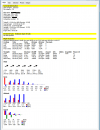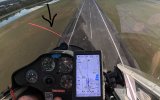- Thread Starter
- #301
The Pawnee tow plane is going back together now.
A new cylinder and piston and studs to hold it all together.
They'll probably finish it in a couple of weeks. Ken is 83 (I think) and he's the lead on the repair.
---
The weather this summer hasn't been very good. Few people show up to fly, it's real hot, etc.
There were 3 today, out of over 100. One couldn't fly because no Instructor available, the other couldn't take him as a passenger/copilot because he is a little stale on recent flight time to be legal.
I flew today, but only got an hour and 48 minutes.
First one up, last one down.
There were some showers around, but nothing near nor violent. Good thermals around, lots of sunshine between the clouds.
But near the end, the lift just seemed to quit. The air was very smooth, no bumps where there usually are.
So, turned back toward the airport. There was a big dark gray bottomed cloud over the field that looked really promising, but I couldn't find anything to keep me up underneath it. Flew on past it toward the west, and started a big curve to to the south to set up to land since I was low, and that cloud had opened it's valves and dumped rain behind me on the airport.
Curving back toward the airport, surprised to see the rain, skirted the edge, couldn't see the south end of the runway (my target area) at all.
Hmmm... not so good.
Press on, use some landmarks to get where I needed to be for the turn to final, entered the rain (no choice but to) and could see (barely) the very south end of the runway, and I knew I had that made.
Rain on the plane decreases its efficiency, so didn't have to use the flaps to increase the descent rate at all.
Ended up a little lower than I would like, and just skimmed down the runway in "ground effect" a couple of thousamd feet till I ran out of energy. Navigated by staying centered between the edges of the runway (that I could see to the sides). Couldn't really see anything forward.
Rolled a few feet off the runway and just sat there for 10 or fifteen minutes till the Liquid Sunshine subsided.
The heavier rain was behind me by this time.
No wipers, so I leave it to you to imagine the visual smear coming through the rain at 60mph committed to a landing.

So, a bit of a lesson learned today. Maybe. At least I didn't compound mistakes.
The north end of the runway was clear of rain, but the wind would be at my back.
Landing in the other direction would probably have been more prudent, had I thought of it earlier, though the wind would have been at my back.
---
Put some Rain-X for Plastic that I bought recently on the canopy after things dried out some. Haven't used it before, not having any plastic windows upon which to use it.
I use the Rain-X for glass on the car, wouldn't want to be without it.
Now I'll probably never get caught in the rain again.
---
I'll likely go out again tomorrow. The forecast looks flyable.
The usual summer "might rain" forecast, of course.

Last Wednesday we were all set up and ready to fly, and a storm blew past between 11am and noon.
That wets the ground, and kills thermals after the sun comes out again, so everybody went home.
A new cylinder and piston and studs to hold it all together.
They'll probably finish it in a couple of weeks. Ken is 83 (I think) and he's the lead on the repair.
---
The weather this summer hasn't been very good. Few people show up to fly, it's real hot, etc.
There were 3 today, out of over 100. One couldn't fly because no Instructor available, the other couldn't take him as a passenger/copilot because he is a little stale on recent flight time to be legal.
I flew today, but only got an hour and 48 minutes.
First one up, last one down.
There were some showers around, but nothing near nor violent. Good thermals around, lots of sunshine between the clouds.
But near the end, the lift just seemed to quit. The air was very smooth, no bumps where there usually are.
So, turned back toward the airport. There was a big dark gray bottomed cloud over the field that looked really promising, but I couldn't find anything to keep me up underneath it. Flew on past it toward the west, and started a big curve to to the south to set up to land since I was low, and that cloud had opened it's valves and dumped rain behind me on the airport.
Curving back toward the airport, surprised to see the rain, skirted the edge, couldn't see the south end of the runway (my target area) at all.
Hmmm... not so good.
Press on, use some landmarks to get where I needed to be for the turn to final, entered the rain (no choice but to) and could see (barely) the very south end of the runway, and I knew I had that made.
Rain on the plane decreases its efficiency, so didn't have to use the flaps to increase the descent rate at all.
Ended up a little lower than I would like, and just skimmed down the runway in "ground effect" a couple of thousamd feet till I ran out of energy. Navigated by staying centered between the edges of the runway (that I could see to the sides). Couldn't really see anything forward.
Rolled a few feet off the runway and just sat there for 10 or fifteen minutes till the Liquid Sunshine subsided.
The heavier rain was behind me by this time.
No wipers, so I leave it to you to imagine the visual smear coming through the rain at 60mph committed to a landing.
So, a bit of a lesson learned today. Maybe. At least I didn't compound mistakes.
The north end of the runway was clear of rain, but the wind would be at my back.
Landing in the other direction would probably have been more prudent, had I thought of it earlier, though the wind would have been at my back.
---
Put some Rain-X for Plastic that I bought recently on the canopy after things dried out some. Haven't used it before, not having any plastic windows upon which to use it.
I use the Rain-X for glass on the car, wouldn't want to be without it.
Now I'll probably never get caught in the rain again.
---
I'll likely go out again tomorrow. The forecast looks flyable.
The usual summer "might rain" forecast, of course.
Last Wednesday we were all set up and ready to fly, and a storm blew past between 11am and noon.
That wets the ground, and kills thermals after the sun comes out again, so everybody went home.


